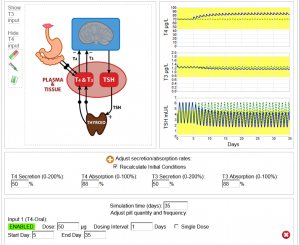Neuroendocrine feedback system modeling & simulation
- Date: April 30, 2015
- People: Marisa Eisenberg (marisae[at]umich.edu), Rotem ben Schacher, Simon Han, Lu Chen, Dylan Hoang, ...
- Keywords: keywords
- Website
THYROSIM Apps for Education and Research on Human Thyroid Hormone Regulation Dynamics
We developed THYROSIM to facilitate education and research activities in endocrinology and metabolism. Behind the scenes, runs as a well-validated and mechanistically-based model of human thyroid hormone regulation dynamics.
The simple and intuitive user interface facilitates running simulated “what-if” experiments. User-selectable “experimental” test-input dosages (oral, IV-pulses, IV-infusions) are represented by animated graphical icons integrated with a cartoon of the hypothalamic-pituitary-thyroid axis. Simulations of familiar hormone (T3, T4 and TSH) temporal dynamic responses to these exogenous stimuli are reported graphically along with normal ranges on the same single-page; and multiple sets of simulated experimental results are superimposable, to facilitate comparative analyses. Importantly, it is freely accessible to researchers, teachers and clinicians, from virtually anywhere, on modern hand-held devices as well as computers. It accurately reproduces a wide range of published clinical study data reporting hormonal kinetic responses to large and small oral hormone challenges. Simulation examples of treated and untreated hypothyroidism, partial-thyroidectomies and malabsorption illustrate typical usage, by optionally changing thyroid gland secretion and/or gut absorption rates – expressed as percentages of normal – adding oral hormone dosing, all directly on the interface, and visualizing the kinetic responses to these challenges.
THYROSIM app Interface: Simulated hypothyroid patient with 50% hormone secretion + 50 μg T4 oral dose treatment daily from day 5 for a month
